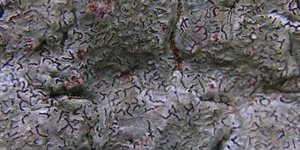Addendum
On the next Saturday (22/6/2013), Andy Cross and Neil Sanderson finished off the 1Km square SU2502. Much of area looked at was also dominated by lichen poor dense heath. However, some patches of interesting wet heath were found and an area of pony ruts leading down to a watering hole at the edge of Duckhole Bog provide to be a rich site (SU2563 0256). The latter added Cladonia incrassata (Nb, NS), Cladonia digitata and Cladonia callosa (Nb, NS) to the 1km square list. These were found on the higher and drier ruts, with a little Marsh Clubmoss Lycopodiella inundata below on the wetter soil.
The final list for the heathland in SU2501 was 34 taxa and a CCP index (Cetraria/Cladonia/Pycnothelia index) score of 24, (high quality heathland lichens sites typically scoring over 15).
Near the watering hole we briefly looked at a standing dead Pine(SU 2563 0255). This was quite interesting with Lecanora aitema, Chrysothrix flavovirens, Lecanora conizaeoides f. conizaeoides, a poorly formed Calicium & odd thing which I collected. This had angular gyrose disks with in rolled margins. The exciple was dark brown and the hypothecium brown with the hymenium hyaline, this went I + pale blue when the iodine first reached it, then deep rusty red as the full solution reached the material. The spores were simple and 5 – 6 x 3 – 4μm, the asci clavate and stained light blue with K/I but with darker staining at the apex. This was a very good match for Elixia flexella NT (NR), which is what I thought it might be when I collected it. There were a couple of issues, however; the hymenium was supposed to be I + pale blue with no mention of it then turning deep rust red and there was no description of the Elixia-type asci in the LGBI (an omission that needs correcting in next edition). A section from voucher material of Elixia flexella from Abernethy Forest, identified by Brian Coppins and collected on the 2000 BLS Pinewood Workshop, however, was identical. The hymenium also going I + pale blue then deep rusty red. I then found a description of the Elixia-type asci in Spribille & Lumbscha (2010) A new species of Elixia (Umbilicariales) from Greece, The Lichenologist 42(4): 365–371. Along with a photograph of K/I stained Elixia asci looking the same as mine, interestingly they describe their species, Elixia cretica, as having a I + deep rust red hymenium, and giving this as a difference with Elixia flexella, however, I found both Scottish and English material of Elixia flexella both went rusty after going blue.
This is the first English record in the BLS database, but the FRDBI gives a record for 1867 from High Rocks Tunbridge Wells. This, however, turns out to be a painting named Peziza flexella by R. Deakin, with the habitat given as on Hazel chips. The latter is enough to suggest this an error, possibly an original miss-identification with a Durella sp (with a hymenium I–; not easy to check in a painting!).
Elixia flexella appears to be confined to old growth woods in Scotland, mainly on dead Pines in native Pine woods but has been found rarely on dead Oak in temperate deciduous woodland. What it is doing on a dead pine in a heathland in the New Forest is not clear. Pine is a definite but quite old reintroduction to the Forest, the first plantings were clearly documented in the late 18th century. There is however a rich dead wood assemblage on the old growth pasture woodland on Oak lignum, so perhaps Elixia flexella occurs in the nearby woods but has ben over looked. Alternatively Elixia flexella is more mobile than existing records suggest.



